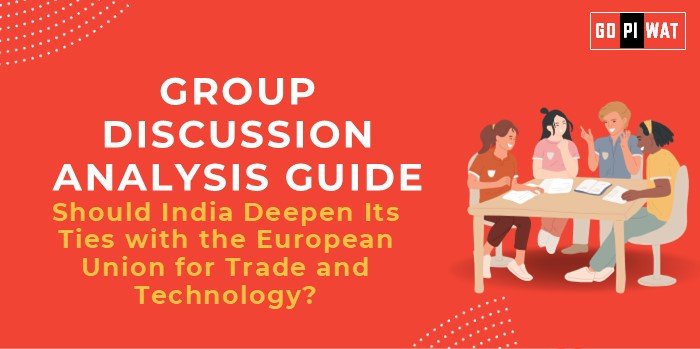📋 Group Discussion (GD) Analysis Guide: Should India Deepen Its Ties with the European Union for Trade and Technology?
🌐 Introduction to the Topic
Opening Context: In an era marked by rapid technological advances and economic interdependence, India and the European Union (EU) stand as natural partners. Both represent significant markets and innovation hubs, making their collaboration pivotal for global stability and progress.
Topic Background: The India-EU relationship has evolved since the early 1960s. With the EU being India’s third-largest trading partner, the collaboration spans sectors like trade, technology, climate change, and global governance. The ongoing negotiations for the India-EU Free Trade Agreement (FTA) aim to unlock new opportunities, particularly in technology transfer, green energy, and market access.
📊 Quick Facts and Key Statistics
- 📈 India-EU Trade Volume: $132 billion in FY 2022-23 (significant indicator of economic ties).
- 💻 Digital Investment Potential: EU firms account for nearly 20% of India’s technology FDI inflow.
- 🌱 Green Collaboration: EU committed €2 billion under the Green Energy Partnership with India (2023).
- 🌍 Market Complementarity: India’s services and digital growth complement the EU’s manufacturing prowess.
🧩 Stakeholders and Their Roles
- 🇮🇳 Indian Government: Negotiating FTAs, fostering investments, and building regulatory frameworks.
- 🇪🇺 EU Institutions: Facilitating trade policies, fostering innovation funding, and ensuring policy alignment.
- 🏢 Private Sector: Tech companies driving innovation and cross-border partnerships.
- 🌍 Global Citizens: Benefiting from job creation, technological access, and cultural exchanges.
🏆 Achievements and Challenges
- 🌟 Achievements:
- Trade Growth: India’s exports to the EU grew by 30% in FY 2022-23.
- Research Alliances: Joint projects under Horizon Europe in AI, quantum computing, and biotech.
- Sustainability: Green partnerships promoting renewable energy and climate-resilient technologies.
- ⚠️ Challenges:
- Tariff Barriers: High duties on Indian exports like textiles and leather.
- Regulatory Differences: Variances in data privacy (GDPR) and trade standards.
- Strategic Divergence: Differing views on geopolitical issues like Russia and China.
🔍 Global Comparisons
- 🌏 China-EU Trade: China has a $560 billion trade volume with the EU, showcasing potential growth for India.
- 🌟 Japan-EU Digital Partnership: A model for India to deepen its tech ties.
📖 Case Studies
- 📍 Bengaluru-European Startups: Collaborative AI research hubs have emerged.
- 🔋 Clean Energy Corridor: EU funding solar power projects in Tamil Nadu.
🖋️ Structured Arguments for Discussion
- ✅ Supporting Stance: “Deepening ties with the EU will enhance India’s global trade position, particularly in high-tech sectors like AI and renewable energy.”
- ❌ Opposing Stance: “India’s trade diversification strategy may over-rely on the EU, risking economic vulnerabilities in other global markets.”
- ⚖️ Balanced Perspective: “While fostering deeper ties with the EU is essential for technology transfer and sustainability, India must safeguard its domestic interests and diversify global partnerships.”
💡 Effective Discussion Approaches
- 📜 Opening Approaches:
- Start with the trade data showcasing the EU as India’s third-largest trading partner.
- Highlight the role of technology partnerships in addressing climate change.
- 🎯 Counter-Argument Handling:
- Acknowledge trade barriers and propose mutual tariff reductions.
- Suggest leveraging regional collaborations to balance geopolitical concerns.
🔍 Strategic Analysis of Strengths and Weaknesses
- 📈 Strengths: Growing trade volumes, shared commitment to sustainability, technological complementarity.
- ⚠️ Weaknesses: Trade imbalance concerns, limited alignment on some geopolitical issues.
- 🌟 Opportunities: Leveraging EU green technology for India’s energy transition, digital collaboration in cybersecurity and AI.
- ⚡ Threats: Competitive EU-China relationships, regulatory constraints on data localization.
📄 Connecting with B-School Applications
- 🌍 Real-World Applications:
- Business strategies to bridge trade barriers.
- Use cases in sustainable finance projects.
- 💡 Sample Interview Questions:
- “How can India benefit from EU’s Green Deal?”
- “What are the risks of over-dependence on the EU for technology?”
- ✨ Insights for B-School Students:
- Understand the impact of global regulatory frameworks.
- Explore cross-border trade and tech synergy projects.


